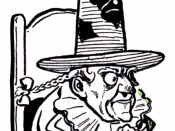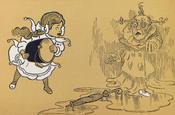The Oz. in Oz
The late 19th century was a time of drastic internal improvements in the United States. During this "Gilded Age," The Democratic platform and the silver standard captivated Baum. Baum supported William Jennings Bryan, the Democratic candidate for President in 1896. Jennings Bryan, however, lost the election. Baum, an already accomplished children's author, then wrote The Wizard of Oz, as an allegory of the Populists' failed efforts to reform the nation in 1896. The Wizard of Oz is a book with fantasy characters for children, but it also reflects the failed Populist reform.
Born in Chittenango, New York on 15 May 1856, Baum was born into a middle class family. In 1868, he went to the Peekskill Military Academy, but left quickly. In 1897, he published Mother Goose in Prose, which was his first collection of fairy tales. Two years later in 1899, he published Father Goose in Prose ("Baum, Frank" ).
In 1900, he published his best-known work The Wizard of Oz (Wang). Baum also published several other books under pseudonyms; however, none brought in the support like the many other Oz related books he wrote (Rahn X ).
Sixty-four years after Baum's original publication of The Wizard of Oz, Henry M. Littlefield and his high school students formulated the theory that The Wizard of Oz (from here on "WOZ") was actually a political allegory, and eighty years later WOZ started to be taught as a political allegory (Wang). Why did sixty-four years pass from the original date of publication before someone formulated a theory that WOZ was a political allegory? Further still, why did eighty years pass from the original date of publication before the general public accepted this theory and began teaching it in schools? It took this amount of time...



Symbolism in the Wizard of OZ
Very interesting Story!! your theory Wizard = president. Emerald city = Washington dc. Wicked witch = bankers.
very cleaver but does it materhow it was thought of?? The story Wizard of oz is a very good story and has lasted the critic's of time I saw enjoy the book and dont think of how or why it was made.
6 out of 7 people found this comment useful.